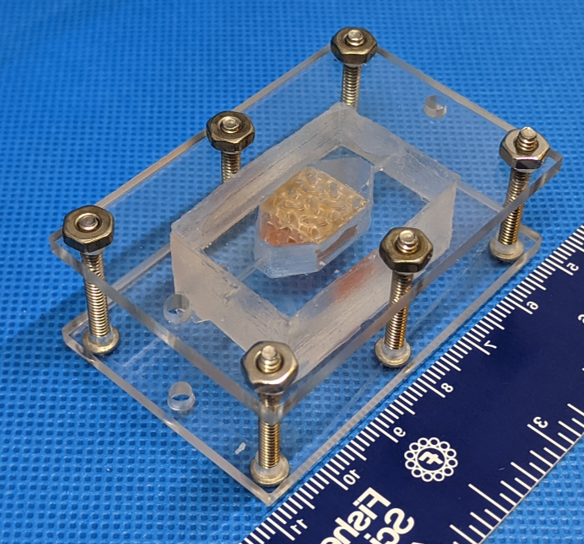Two research teams from Wake Forest University's Institute for Regenerative Medicine have won NASA's long-running Vascular Tissue Challenge by 3D printing a biologically viable slice of human liver.
Winston and WFIRM created a centimeter-square slice of meat capable of surviving and nominally functional for 30 days, although utilizing different approaches.
According to an agency challenge description, NASA launched this competition in 2016 to discover teams who could "create thick, vascularized human organ tissue in an in-vitro environment to advance research and benefit medicine on long-duration missions and on Earth," The agency revealed not one, but two winners of the challenge on June 9.

Team Winston, the first-place winner of NASA's Vascular Tissue Challenge, used a chamber to hold the printed tissue and test a process called perfusion.
Both teams used "3D printing technologies to create gel-like molds, or scaffolds, with a network of channels designed to maintain sufficient oxygen and nutrient levels to keep the constructed tissues alive." However, NASA admits that their printing designs and materials differed.
"I cannot overstate what an impressive accomplishment this is. When NASA started this challenge in 2016, we weren't sure there would be a winner," Jim Reuter, NASA associate administrator for space technology, said in a recent press statement made by NASA. "It will be exceptional to hear about the first artificial organ transplant one day and think this novel NASA challenge might have played a small role in making it happen," Reuter added.
Winston to Receive $300,000 to Develop Technology, Send Experiments to ISS
Winston was declared the winner, and the team will receive not only $300,000 to further develop the technology. They will also have the opportunity to send their experiment to the International Space Station for further testing. After all, you've got to make sure that the next lab-printed liver is sufficiently RAD resistant. The WFIRM team will receive $100,000 to continue their research, but not an orbital voyage.
ALSO READ: Is This Lab-Made Ouroboros Steak Ethical To Eat? Experts Say Yes
The medical procedures and products that this study could lead to could be game-changing. Rather than relying on a network of volunteers, organ transplant candidates of the future may be able to have their replacement organs printed ahead of time, completely eliminating the risk of rejection and nearly guaranteeing a complete genetic organ match every time.
"The value of an artificial tissue depends entirely on how well it mimics what happens in the body," Lynn Harper, challenge administrator at NASA's Ames Research Center, said per SpaceRef. Harper explained that the needs are specific and differ from one organ to the next. As a result, the task is challenging and time-consuming. "The research resulting from this NASA challenge represents a benchmark, a well-documented foundation to build the next advance upon," Harper added.
3D-Printing Human Tissues in Space
It remains unclear how scientists might use this technology in the future to provide healthcare to astronauts on missions to the moon and Mars. However, the researchers behind these projects are well aware of the numerous difficulties that their application poses.
"There's going to be zero gravity ... space radiation, and we don't know how these tissues or cells within the tissue would behave. So, there are so many unanswered questions," James Yoo, a professor at WFIRM who is a part of team Winston, told Space-.com.
While these future uses of tissue engineering have yet to be observed, researchers can dramatically increase our understanding of how they might work. They will examine these structures in space, such as on the space station.
NASA's Vascular Tissue Challenge is part of the Centennial Challenges. It has challenges, rewards, and crowdsourcing programs inside NASA's Space Technology Mission Directorate. The agency's Ames Research Center leads it in Silicon Valley. NASA collaborated on this challenge with the nonprofit New Organ Alliance, which focuses on regenerative medicine research and development, and assembled the nine-person judging panel.
RELATED ARTICLE: SpaceX Dragon Spacecraft Sends Glow-in-the-Dark Baby Squids to the ISS for NASA Space Experiments
Check out more news and information on Biology and Space in Science Times.













![Earth's Quasi-Moon Kamo‘oalewa Could Originate From Lunar Surface Not Asteroid Belt [Study]](https://1721181113.rsc.cdn77.org/data/thumbs/full/53275/258/146/50/40/earths-quasi-moon-kamo-oalewa-could-originate-from-lunar-surface-not-asteroid-belt-study.png)
